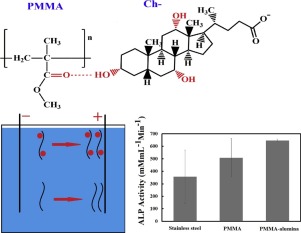当前位置:
X-MOL 学术
›
Colloids Surf. B Biointerfaces
›
论文详情
Our official English website, www.x-mol.net, welcomes your
feedback! (Note: you will need to create a separate account there.)
Electrophoretic deposition of polymethylmethacrylate and composites for biomedical applications.
Colloids and Surfaces B: Biointerfaces ( IF 5.4 ) Pub Date : 2019-12-26 , DOI: 10.1016/j.colsurfb.2019.110763 A D'Elia 1 , J Deering 1 , A Clifford 1 , B E J Lee 2 , K Grandfield 3 , I Zhitomirsky 3
Colloids and Surfaces B: Biointerfaces ( IF 5.4 ) Pub Date : 2019-12-26 , DOI: 10.1016/j.colsurfb.2019.110763 A D'Elia 1 , J Deering 1 , A Clifford 1 , B E J Lee 2 , K Grandfield 3 , I Zhitomirsky 3
Affiliation

|
For the first time, an electrophoretic deposition (EPD) method has been developed for the deposition of polymethylmethacrylate (PMMA) and PMMA-alumina films for biomedical implant applications. The proposed biomimetic approach was based on the use of a bile salt, sodium cholate (NaCh), which served as a multifunctional solubilizing, charging, dispersing and film-forming agent. Investigations revealed PMMA-Ch- and PMMA-alumina interactions, which facilitated the deposition of PMMA and PMMA-alumina films. This approach allows for the use of a non-toxic water-ethanol solvent for PMMA. The proposed deposition strategy can also be used for co-deposition of PMMA with other functional materials. The PMMA and composite films were tested for biomedical implant applications. The PMMA-alumina films showed statistically improved metabolic results compared to both the bare stainless steel substrate and pure PMMA films. Alkaline phosphatase (ALP) activity affirmed the bioactivity and osteoconductive potential of PMMA and composite films. PMMA-alumina films showed greater ALP activity than both the PMMA-coated and uncoated stainless steel.
中文翻译:

用于生物医学应用的聚甲基丙烯酸甲酯和复合材料的电泳沉积。
首次开发了电泳沉积(EPD)方法,用于生物医学植入物应用中的聚甲基丙烯酸甲酯(PMMA)和PMMA-氧化铝薄膜的沉积。拟议的仿生方法基于胆汁盐胆酸钠(NaCh)的使用,该胆碱盐可作为多功能增溶,带电,分散和成膜剂。研究表明,PMMA-Ch-和PMMA-氧化铝相互作用促进了PMMA和PMMA-氧化铝膜的沉积。这种方法允许对PMMA使用无毒的水-乙醇溶剂。所提出的沉积策略也可以用于PMMA与其他功能材料的共沉积。对PMMA和复合膜进行了生物医学植入物应用测试。与裸露的不锈钢基板和纯PMMA膜相比,PMMA-氧化铝膜均显示出统计学上改善的代谢结果。碱性磷酸酶(ALP)的活性证实了PMMA和复合膜的生物活性和骨传导潜能。PMMA-氧化铝膜显示出比PMMA涂层和未涂层不锈钢都更高的ALP活性。
更新日期:2019-12-27
中文翻译:

用于生物医学应用的聚甲基丙烯酸甲酯和复合材料的电泳沉积。
首次开发了电泳沉积(EPD)方法,用于生物医学植入物应用中的聚甲基丙烯酸甲酯(PMMA)和PMMA-氧化铝薄膜的沉积。拟议的仿生方法基于胆汁盐胆酸钠(NaCh)的使用,该胆碱盐可作为多功能增溶,带电,分散和成膜剂。研究表明,PMMA-Ch-和PMMA-氧化铝相互作用促进了PMMA和PMMA-氧化铝膜的沉积。这种方法允许对PMMA使用无毒的水-乙醇溶剂。所提出的沉积策略也可以用于PMMA与其他功能材料的共沉积。对PMMA和复合膜进行了生物医学植入物应用测试。与裸露的不锈钢基板和纯PMMA膜相比,PMMA-氧化铝膜均显示出统计学上改善的代谢结果。碱性磷酸酶(ALP)的活性证实了PMMA和复合膜的生物活性和骨传导潜能。PMMA-氧化铝膜显示出比PMMA涂层和未涂层不锈钢都更高的ALP活性。










































 京公网安备 11010802027423号
京公网安备 11010802027423号